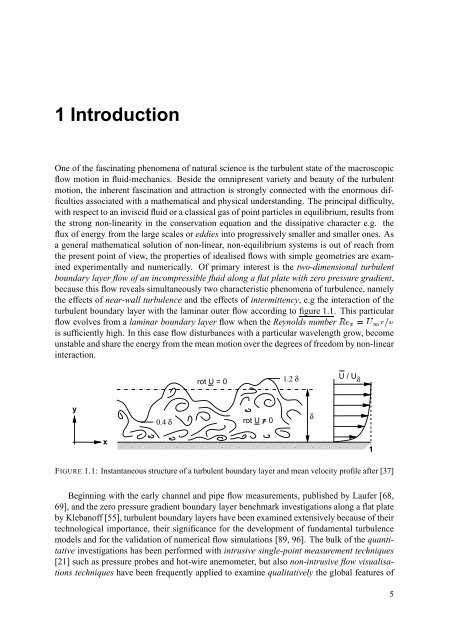The significance of coherent flow structures for the turbulent mixing ...
The significance of coherent flow structures for the turbulent mixing ...
The significance of coherent flow structures for the turbulent mixing ...
Create successful ePaper yourself
Turn your PDF publications into a flip-book with our unique Google optimized e-Paper software.
1 Introduction<br />
One <strong>of</strong> <strong>the</strong> fascinating phenomena <strong>of</strong> natural science is <strong>the</strong> <strong>turbulent</strong> state <strong>of</strong> <strong>the</strong> macroscopic<br />
<strong>flow</strong> motion in fluid-mechanics. Beside <strong>the</strong> omnipresent variety and beauty <strong>of</strong> <strong>the</strong> <strong>turbulent</strong><br />
motion, <strong>the</strong> inherent fascination and attraction is strongly connected with <strong>the</strong> enormous difficulties<br />
associated with a ma<strong>the</strong>matical and physical understanding. <strong>The</strong> principal difficulty,<br />
with respect to an inviscid fluid or a classical gas <strong>of</strong> point particles in equilibrium, results from<br />
<strong>the</strong> strong non-linearity in <strong>the</strong> conservation equation and <strong>the</strong> dissipative character e.g. <strong>the</strong><br />
flux <strong>of</strong> energy from <strong>the</strong> large scales or eddies into progressively smaller and smaller ones. As<br />
a general ma<strong>the</strong>matical solution <strong>of</strong> non-linear, non-equilibrium systems is out <strong>of</strong> reach from<br />
<strong>the</strong> present point <strong>of</strong> view, <strong>the</strong> properties <strong>of</strong> idealised <strong>flow</strong>s with simple geometries are examined<br />
experimentally and numerically. Of primary interest is <strong>the</strong> two-dimensional <strong>turbulent</strong><br />
boundary layer <strong>flow</strong> <strong>of</strong> an incompressible fluid along a flat plate with zero pressure gradient,<br />
because this <strong>flow</strong> reveals simultaneously two characteristic phenomena <strong>of</strong> turbulence, namely<br />
<strong>the</strong> effects <strong>of</strong> near-wall turbulence and <strong>the</strong> effects <strong>of</strong> intermittency, e.g <strong>the</strong> interaction <strong>of</strong> <strong>the</strong><br />
<strong>turbulent</strong> boundary layer with <strong>the</strong> laminar outer <strong>flow</strong> according to figure 1.1. This particular<br />
<strong>flow</strong> evolves from a laminar boundary layer <strong>flow</strong> when <strong>the</strong> Reynolds number<br />
£¡<br />
is sufficiently high. In this case <strong>flow</strong> disturbances with a particular wavelength grow, become<br />
unstable and share <strong>the</strong> energy from <strong>the</strong> mean motion over <strong>the</strong> degrees <strong>of</strong> freedom by non-linear<br />
interaction.<br />
rot U = 0<br />
1.2 δ<br />
U / U δ<br />
y<br />
0.4 δ<br />
rot U = 0<br />
δ<br />
x<br />
1<br />
FIGURE 1.1: Instantaneous structure <strong>of</strong> a <strong>turbulent</strong> boundary layer and mean velocity pr<strong>of</strong>ile after [37]<br />
<br />
<br />
Beginning with <strong>the</strong> early channel and pipe <strong>flow</strong> measurements, published by Laufer [68,<br />
69], and <strong>the</strong> zero pressure gradient boundary layer benchmark investigations along a flat plate<br />
by Kleban<strong>of</strong>f [55], <strong>turbulent</strong> boundary layers have been examined extensively because <strong>of</strong> <strong>the</strong>ir<br />
technological importance, <strong>the</strong>ir <strong>significance</strong> <strong>for</strong> <strong>the</strong> development <strong>of</strong> fundamental turbulence<br />
models and <strong>for</strong> <strong>the</strong> validation <strong>of</strong> numerical <strong>flow</strong> simulations [89, 96]. <strong>The</strong> bulk <strong>of</strong> <strong>the</strong> quantitative<br />
investigations has been per<strong>for</strong>med with intrusive single-point measurement techniques<br />
[21] such as pressure probes and hot-wire anemometer, but also non-intrusive <strong>flow</strong> visualisations<br />
techniques have been frequently applied to examine qualitatively <strong>the</strong> global features <strong>of</strong><br />
5
















